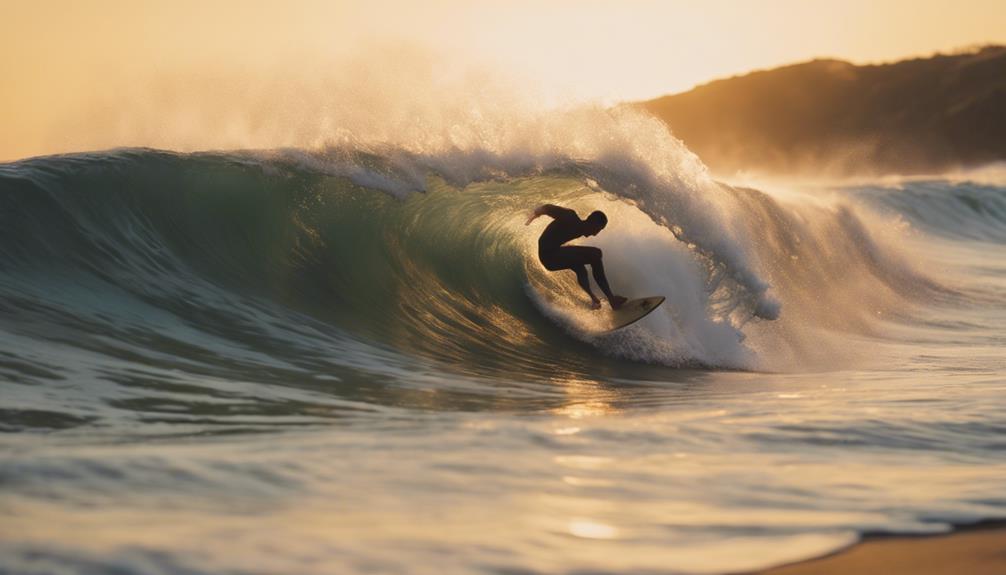Understanding ocean currents helps you spot wave patterns, stay safe, and choose the best surf spots. Surface currents driven by winds move water and influence wave size, while deep currents affect overall water temperature and salinity. Recognizing indicators like foam, debris, and water color can guide you in reading flow directions. By observing these signs and monitoring tools, you’ll improve your surfing skills and safety—keep going to learn more about mastering currents.
Key Takeaways
- Observe surface indicators like foam, debris, and ripple patterns to identify current direction and strength.
- Use tidal charts and buoy data to anticipate how tides influence current flow during surf sessions.
- Recognize that wind-driven surface currents can create rip currents or push waves, affecting surf conditions.
- Detect temperature and color changes underwater to gauge subsurface current patterns and potential hazards.
- Always plan ahead with real-time satellite imagery and forecast tools to understand current behavior at your chosen surf spot.
What Are Ocean Currents?
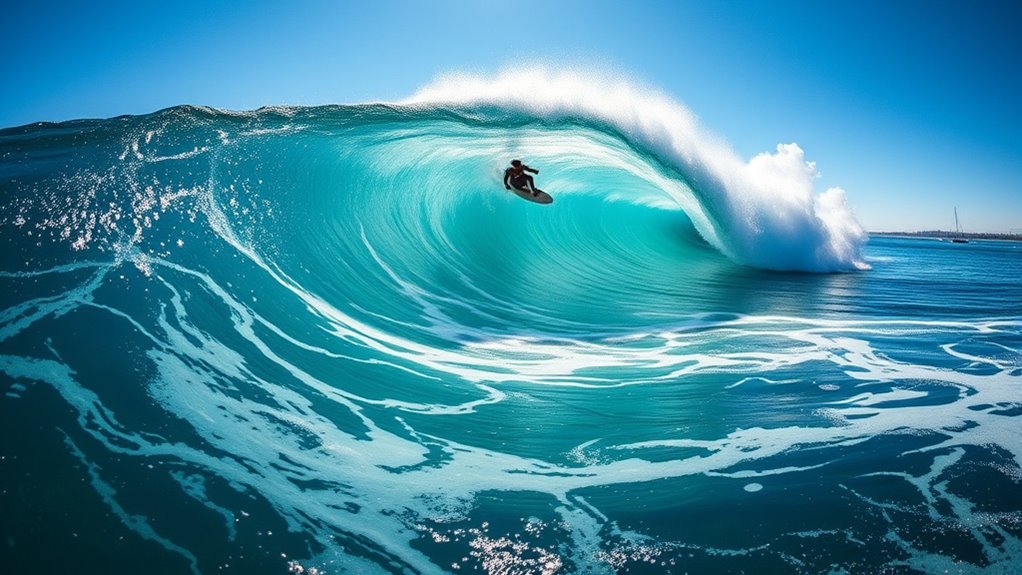
Have you ever wondered how vast areas of the ocean stay in constant motion? Ocean currents are powerful, flowing streams that move water across the globe. They influence marine biodiversity by transporting nutrients and organisms, supporting diverse ecosystems. But these currents also face threats like ocean pollution, which can disrupt marine life and hinder the natural flow. Currents are driven by wind patterns, Earth’s rotation, and differences in water temperature and salinity. They shape climate, weather, and even the distribution of marine species. Understanding what ocean currents are helps you appreciate their role in maintaining a balanced ocean environment. They’re essential for life beneath the waves, yet vulnerable to human impacts that threaten their stability and the health of marine ecosystems.
Types of Ocean Currents and Their Characteristics
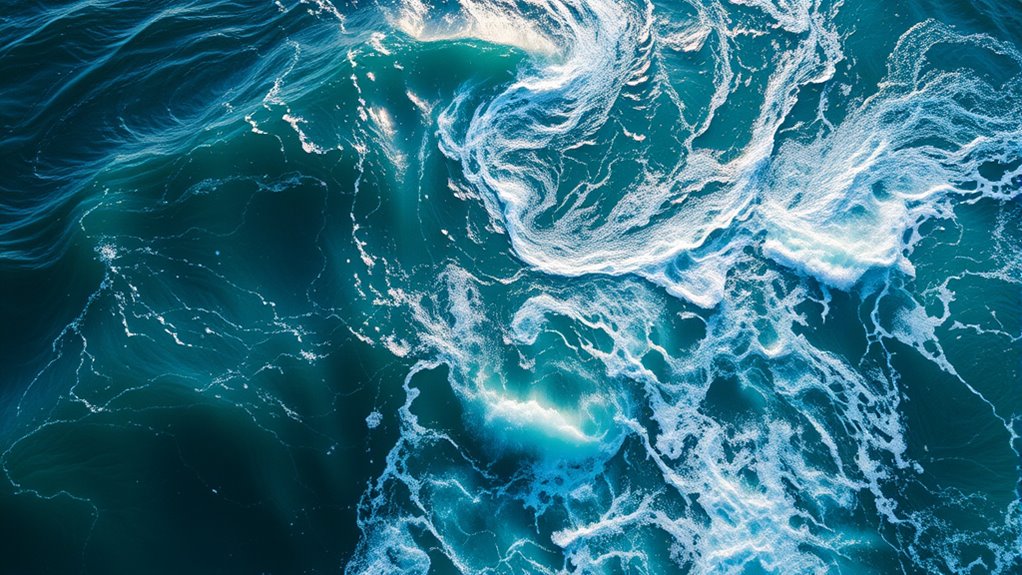
You’ll notice that ocean currents come in different types, mainly surface and deep currents, each playing unique roles. Surface currents are driven by wind and affect the upper layers of the ocean, while deep currents move slowly beneath, influenced by temperature and salinity. Understanding how warm and cold flows differ helps explain their impact on climate and marine life.
Surface vs. Deep Currents
Surface and deep currents are two main types of ocean currents that move water throughout the world’s oceans. Surface currents flow within the upper 400 meters, driven primarily by wind and Coriolis forces, creating features like tidal bores that ripple along coastlines. These currents influence the weather and bring nutrients to the surface, affecting surf conditions. Deep currents, on the other hand, move water far below the surface, often driven by differences in water density and temperature. You might not see these flows directly, but they play a crucial role in global circulation. Understanding ocean circulation is essential to grasp how these currents interact on a global scale. Underwater springs can also impact local deep currents, releasing cold, nutrient-rich water, which further influences local oceanic nutrient distribution. Recognizing the interplay between surface and deep currents is key to understanding ocean dynamics and how they affect marine environments and surf patterns. Additionally, thermal gradients between water layers help drive the movement of deep currents, linking temperature differences to global ocean circulation patterns.
Warm vs. Cold Flows
Warm and cold ocean currents differ markedly in their temperature and impact on the environment. Warm flows, usually near the equator, create distinct thermal layering, raising surface temperatures and affecting local climates. Cold currents, originating from polar regions, bring cooler water to the surface, often reducing water temperature and influencing weather patterns. The temperature difference affects current speed; cold currents tend to move faster due to denser water, while warm currents are generally slower. As a surfer, understanding these variations helps you anticipate wave conditions and water temperature. Warm flows can produce softer, more inviting surf, while cold flows often generate more powerful, energetic waves. Recognizing the thermal layering and current speed helps you prepare for different surf environments and stay safe in changing conditions. Additionally, vetted pinball machines can serve as a fun way to learn about environmental science and oceanography in a recreational setting. Understanding ocean current dynamics further enhances your knowledge of how these flows influence coastal ecosystems and surf quality. Being aware of thermal layering also aids in predicting how water temperature may affect your surfing experience. Moreover, research-backed data on ocean currents supports better predictions of surf conditions and environmental changes.
How Ocean Currents Are Formed
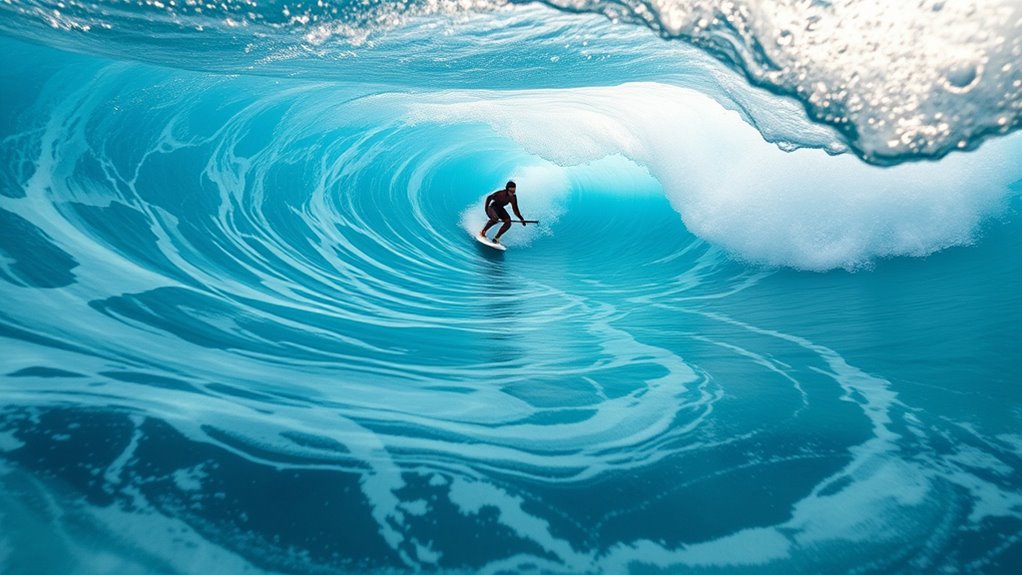
You can see that wind plays a major role in driving ocean currents, pushing water across the surface. Earth’s rotation causes these currents to curve, shaping their paths worldwide. Additionally, differences in temperature and salinity create variations in water density, further influencing current formation. Understanding city dynamics is also essential for predicting how currents might affect coastal areas and local environments. Understanding Gold IRA rollovers can be complex, but it highlights the importance of strategic planning in financial investments.
Wind Influence on Currents
Have you ever wondered how winds shape the vast movements of ocean water? Winds are a primary force behind the formation of surface currents, influencing their speed and direction. As wind blows across the ocean’s surface, it drags water along, creating currents that can travel thousands of miles. These currents interact with factors like tidal patterns and undersea topography, which further channel and modify their paths. For example, undersea ridges and valleys direct water flow, amplifying current strength in specific areas. Additionally, wind-driven surface currents often lead to upwelling zones rich in nutrients, essential for marine life and surfing conditions. Understanding how wind influences currents helps you predict swell patterns and locate the best surf spots. Healthy Kid Play can also include activities like movement exercises that mimic the flow of currents, making learning about ocean dynamics more engaging.
Earth’s Rotation Effects
Earth’s rotation plays a crucial role in shaping ocean currents through a phenomenon called the Coriolis effect. This force causes moving water to deflect to the right in the Northern Hemisphere and to the left in the Southern Hemisphere, influencing current direction. Tidal effects, driven by the moon’s gravitational pull, interact with Earth’s rotation to create complex flow patterns near coastlines. Underwater topography also impacts how currents form and move, guiding water along ridges, valleys, and continental shelves. As ocean water responds to Earth’s rotation, tidal forces, and underwater features, large-scale currents develop that can influence surf conditions. Recognizing how these factors interplay helps you better understand the patterns and behaviors of ocean currents, essential for safe and strategic surfing. Understanding ocean dynamics is key to predicting surf conditions more accurately. Additionally, corresponding wind patterns often work in tandem with ocean currents, further affecting surf quality and safety. The interaction of these forces can also lead to the formation of upwelling zones, which bring nutrient-rich waters to the surface, affecting marine life and surf conditions.
Temperature and Salinity
Temperature and salinity are key factors that determine how ocean currents form and move. Variations in water temperature create density differences that drive thermohaline circulation, influencing surface and deep currents. Thermohaline circulation plays a crucial role in distributing heat and nutrients across the globe. Salinity levels, affected by freshwater input and evaporation, also impact water density. Tidal effects mix water layers, modifying temperature and salinity distributions, which in turn affect current paths. Marine life responds to these changes, often thriving in areas with specific temperature and salinity conditions. You’ll notice that:
- Tidal movements influence local current strength
- Warm waters tend to rise, shaping surface currents
- Cold, dense water sinks, driving deep currents
- Salinity fluctuations affect nutrient distribution
- These factors collectively impact surf conditions and marine ecosystems
Understanding this interplay helps you anticipate surf spots and appreciate the ocean’s dynamic nature. Additionally, oceanic circulation patterns are significantly influenced by variations in temperature and salinity, highlighting the importance of these factors in the overall movement of water masses. Moreover, the density differences caused by temperature and salinity variations are fundamental to understanding how currents are generated and sustained across different ocean layers. Recognizing how water properties change with environmental conditions can deepen your comprehension of ocean behavior and its impact on climate systems.
Furthermore, changes in temperature and salinity can lead to shifts in ocean currents, which may affect weather patterns and marine navigation.
The Impact of Currents on Wave Formation
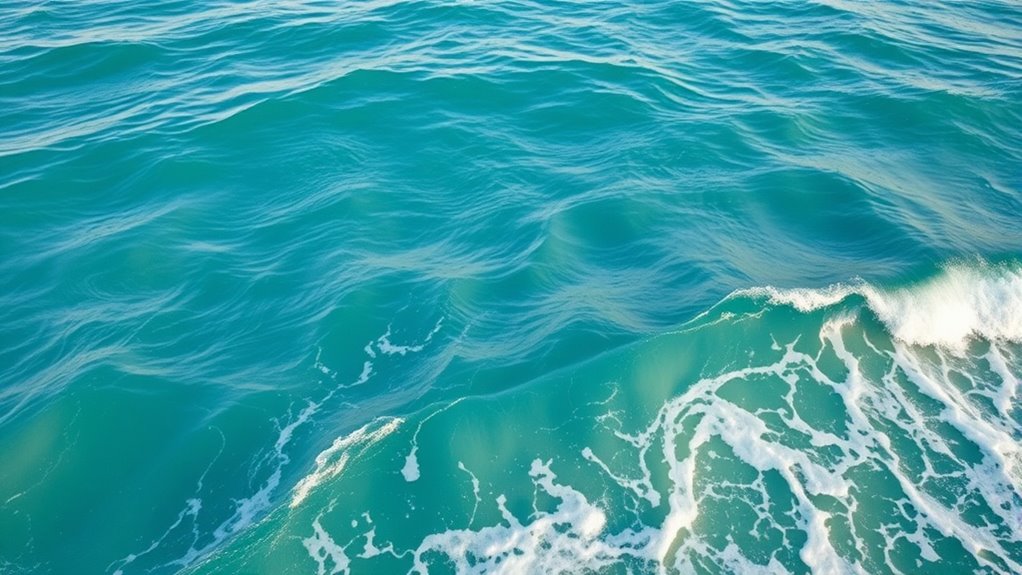
Ocean currents play a crucial role in shaping wave formation, as they transfer energy across vast distances and influence the movement of water surfaces. Tidal influences interact with these currents, amplifying or dampening wave size depending on the timing of tides. Underwater topography, like reefs, sandbars, and continental shelves, guides how waves form and break. When currents flow over submerged features, they cause waves to rise and become steeper, creating ideal conditions for surfing. Strong currents can also focus wave energy, producing larger and more powerful waves. Additionally, being aware of sound recording techniques can help in documenting and analyzing wave patterns for better understanding of surf conditions. Recognizing celebrity lifestyle insights and their impact on coastal environments can enhance your awareness of local surf spots. Conversely, areas with irregular topography or weak currents tend to generate smaller, less consistent waves. Regional divorce statistics and local knowledge of currents can help you identify the best surf spots and anticipate wave behavior, ensuring safer and more enjoyable sessions.
Recognizing Surface Currents and Subsurface Flows
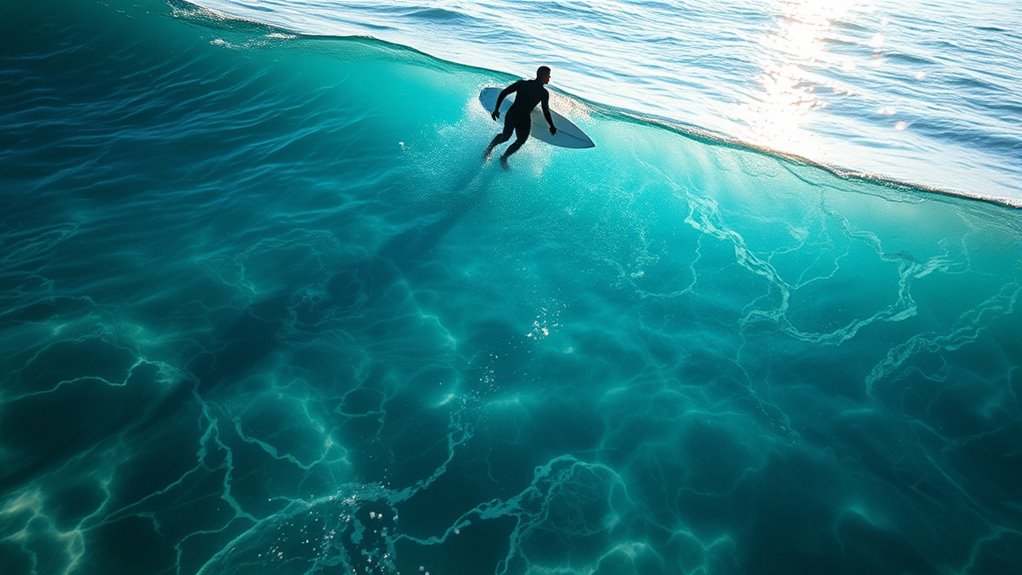
Recognizing surface currents and subsurface flows begins with observing how water moves at different depths and locations. You can identify surface flow by watching the water’s surface for visible signs like ripples, foam, or color shifts. Subsurface movement, however, requires paying attention to less obvious cues, such as changes in water temperature or the direction of debris below the surface. Here are key indicators:
Observe surface ripples, foam, color changes, and debris movement to identify currents and subsurface flows.
- Surface ripples and foam patterns
- Color variations on the water’s surface
- Changes in water temperature at different depths
- Swirling or tugging on submerged objects
- The direction of floating debris or kelp
How to Read Ocean Currents While Surfing
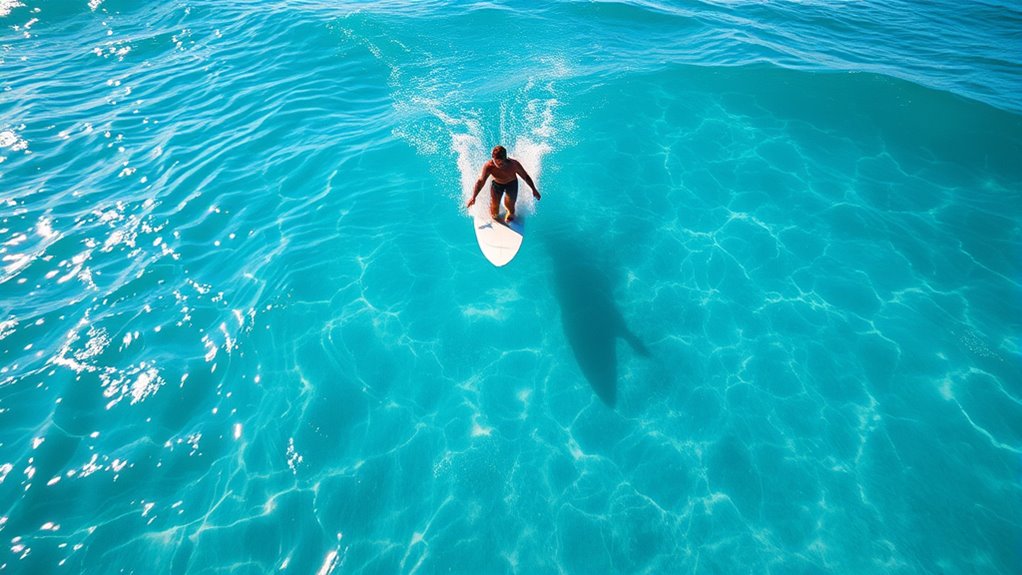
To read ocean currents while surfing, you need to observe how the water moves around you and identify patterns that indicate current direction and strength. Tidal influences play a key role; during high and low tides, currents shift and can either push you toward the shore or pull you away. Watch for surface ripples, foam lines, or debris moving steadily in one direction, which signals a current. Use your experience with marine navigation cues, like the way water flows around rocks or sandbars, to anticipate currents’ paths. Pay attention to changes in water color or texture, as these often mark current boundaries. Recognizing these signs helps you adjust your position and stay safe while making the most of the surf.
Safety Tips for Dealing With Strong Currents
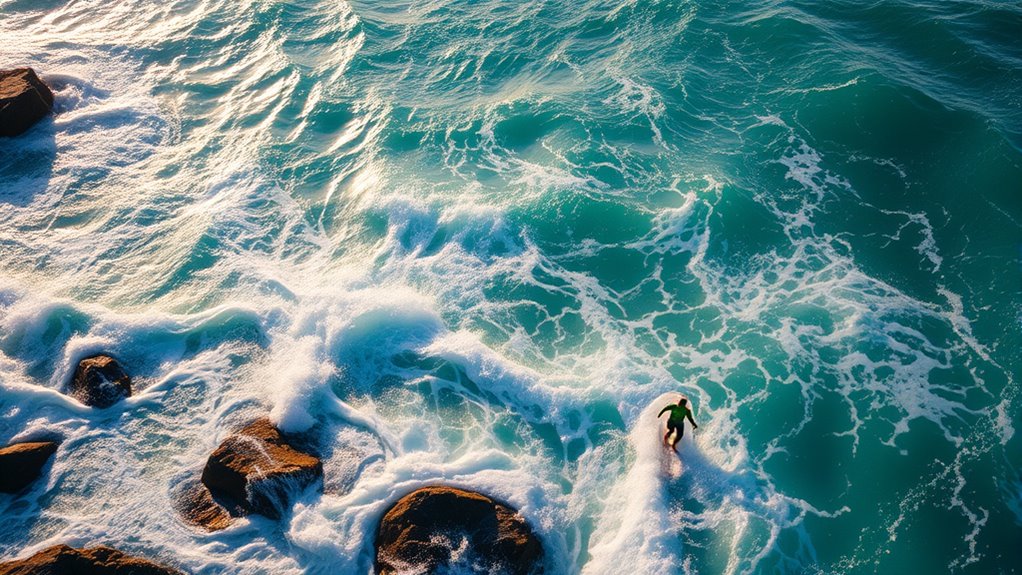
When you encounter strong currents while in the water, staying calm and acting decisively can prevent accidents. Recognize that currents are influenced by factors like underwater topography and marine biodiversity, which shape their strength and direction. To stay safe:
- Signal for help if needed and alert others nearby
- Swim parallel to the shoreline to escape the current
- Avoid fighting the current directly; conserve energy
- Observe sudden changes in underwater topography that may indicate stronger flows
- Stay aware of marine biodiversity that could signal shifting currents or hazards
Understanding these elements helps you navigate safely and avoid dangerous rip tides or undertows. Remaining calm and informed allows you to respond effectively and enjoy your surf session responsibly.
Tools and Resources for Monitoring Currents
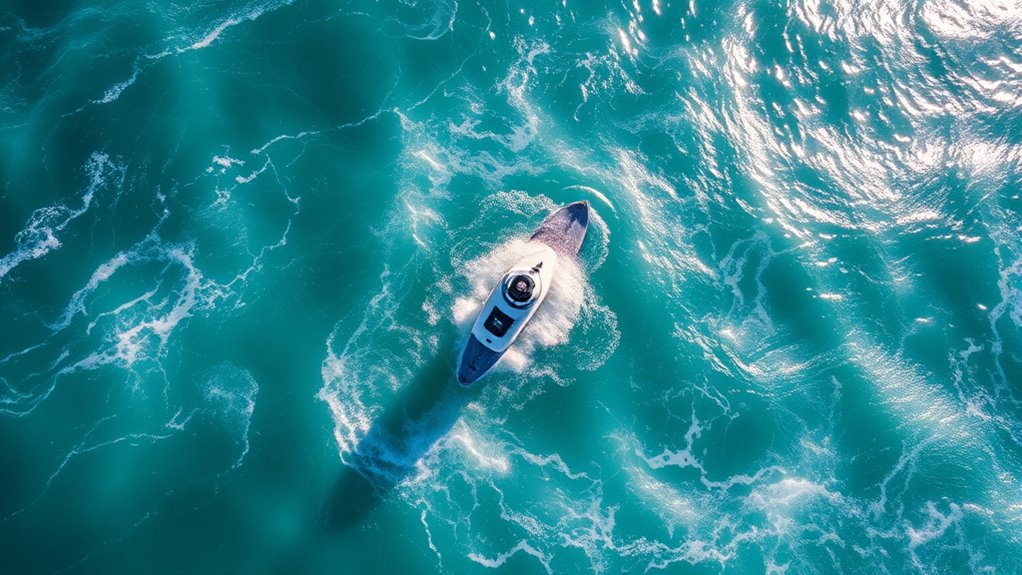
Monitoring ocean currents has become more accessible thanks to a variety of tools and resources designed to keep you informed and safe. Satellite imagery provides real-time visuals of surface currents, helping you identify changes and plan your surf sessions accordingly. Buoy data offers valuable insights into water temperature, wave height, and current strength, giving you on-the-spot information. Many websites and apps compile this data, offering forecast maps and current updates tailored for surfers. By regularly checking satellite imagery and buoy reports, you can better understand current patterns and avoid dangerous areas. These tools empower you to make smarter decisions, enhance your safety, and maximize your surf experience. Staying informed with reliable resources is key to navigating ocean currents confidently.
Tips for Choosing Surf Spots Based on Currents
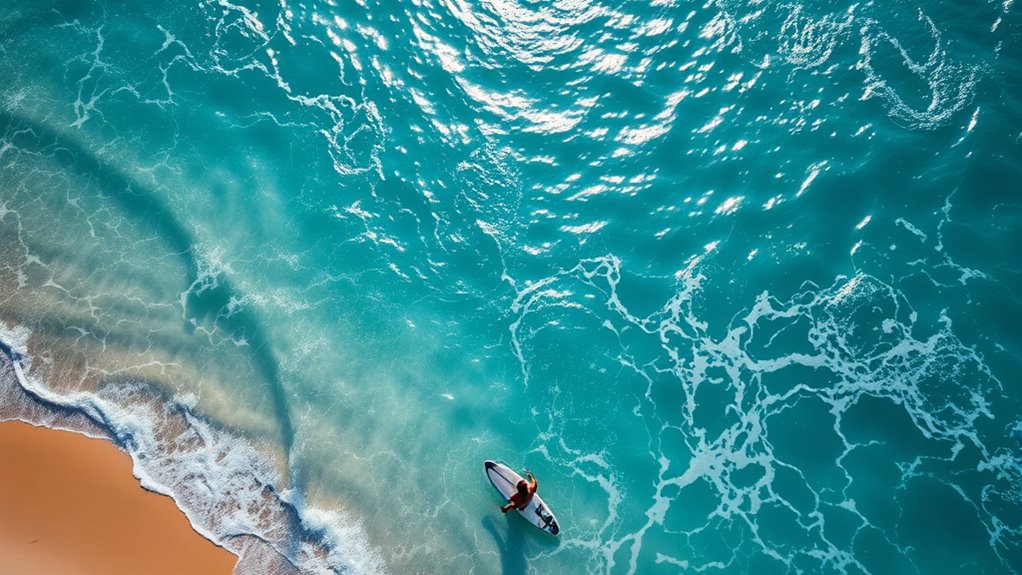
Using tools like satellite imagery and buoy reports can help you identify areas with favorable current conditions before heading out. When choosing surf spots, consider how currents influence marine biodiversity and coastal erosion. Strong currents can promote healthy ecosystems but also reshape coastlines, affecting surf accessibility. Look for spots where currents are predictable and moderate, providing safer, more consistent waves. Avoid areas with rapid or unpredictable currents that could pull you into dangerous zones. Pay attention to local signs of coastal erosion, which may signal shifting underwater topography affecting surf quality. Remember, understanding these currents helps you find spots with ideal wave conditions while protecting marine environments. Balancing surf enjoyment with environmental awareness ensures a sustainable, enjoyable experience.
Frequently Asked Questions
How Do Seasonal Changes Affect Ocean Current Patterns for Surfing?
Seasonal variations and temperature fluctuations considerably impact ocean current patterns, which directly affect your surfing conditions. During different seasons, currents may shift, bringing warm or cold water that influences wave quality and swell direction. You’ll notice stronger or gentler currents depending on the time of year, so stay aware of these changes. Tracking seasonal trends helps you predict the best times and spots for ideal surfing, ensuring you catch the best waves.
Can Ocean Currents Change Unexpectedly During a Surf Session?
Yes, ocean currents can change unexpectedly during a surf session. You might experience unexpected shifts or sudden reversals caused by changing wind conditions, tides, or weather systems. These shifts can catch you off guard, affecting your balance and safety. It’s important to stay alert and observe the water constantly, so you can adapt quickly if you notice any sudden reversals or unusual current patterns emerging while you’re surfing.
How Do Local Topography and Seabed Features Influence Currents?
Local topography and seabed features greatly influence currents. Coastal topography, like cliffs or bays, can channel or block flow, creating stronger or weaker currents. Seabed formations such as ridges, sandbars, and reefs shape how water moves, often causing rip currents or eddies. As a surfer, you should observe these features, as they determine current strength and direction, helping you stay safe and find the best breaks.
Are There Specific Currents That Enhance or Diminish Wave Quality?
Certain currents can definitely enhance or diminish wave quality based on their strength and wave direction. When currents are gentle and align with the wave’s direction, they help maintain clean, well-formed waves, making surfing better. Conversely, strong opposing currents can weaken or break waves prematurely, reducing quality. So, pay attention to the current strength and wave direction, as they directly impact the surf’s consistency and rideability.
How Can Surfers Predict Long-Term Current Shifts in a Region?
To predict long-term current shifts, you should rely on satellite monitoring and historical data. Satellites provide real-time observations of ocean surface patterns, while historical data reveals trends over years. By analyzing these sources, you can identify patterns and anticipate changes in currents for your region. Staying updated with scientific reports and local oceanographic studies also helps you make more accurate long-term predictions, giving you an edge in planning your surf sessions.
Conclusion
By understanding ocean currents, you empower yourself to surf smarter and safer. Recognize how they influence wave patterns and always stay alert to surface and subsurface flows. Use the right tools and heed safety tips to avoid getting swept away, much like steering through treacherous waters in a vessel of yore. With knowledge and vigilance, you’ll ride those waves with confidence, embracing the ocean’s power while respecting its mighty currents.





